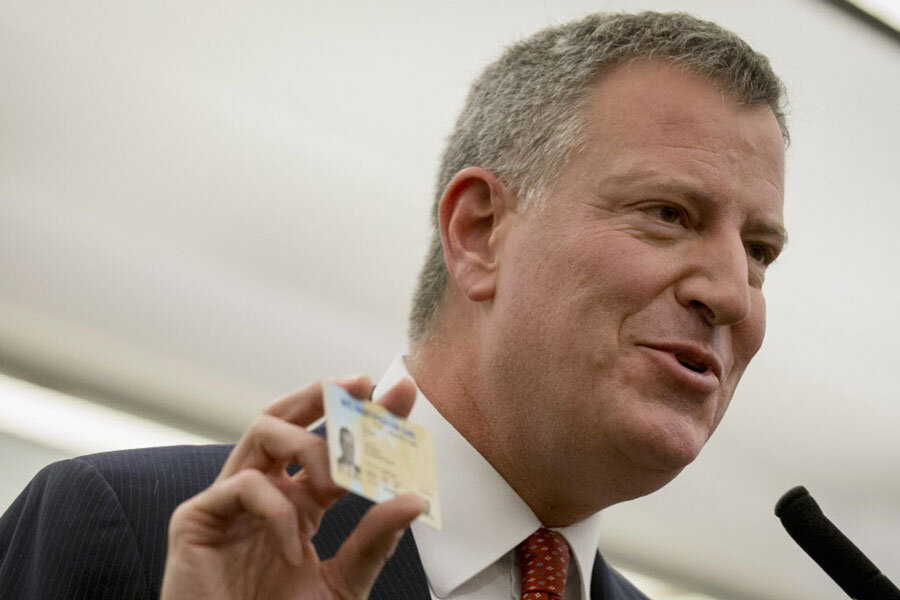Beyond NYPD crisis, New York mayor's first year marked by innovation
| New York
Despite a tumultuous first year and the ongoing crisis with the New York Police Department, the city’s first liberal mayor in 20 years has nevertheless begun to lay the foundations for the significant changes he promised New Yorkers a year ago.
While the tensions with the police department promise to reverberate well into the administration of Mayor Bill de Blasio, his first year was not without significant and potentially lasting accomplishments, many observers say. From the virtually seamless rollout of his signature universal pre-K education plan, to his new long-term affordable housing initiatives, as well as his focus on public health and safety issues and his deft handling of the Ebola crisis, the mayor has made his mark.
On Monday, Mayor de Blasio launched one of his smaller initiatives, the nation’s largest municipal ID program. The new city-resident-only IDs are designed to help New York City’s estimated 500,000 undocumented immigrants, as well as the elderly poor and homeless, to open bank accounts, sign leases, and utilize a variety of the city’s services.
“This is a historic day because for hundreds of thousands of New Yorkers this’ll be the first time they could get any kind of ID,” de Blasio said Monday morning at a library in Queens. “This is the launch of something that will make life better in this city, and it fulfills a promise that we made ... It will mean people can lead fuller lives, better lives – lives full of respect and recognition.”
Indeed, de Blasio has said that his primary intention as mayor has been to foster a fuller life for those at the margins of the bright lights of Manhattan – which he memorably highlighted as a “tale of two cities” in his campaign slogan.
This morning’s lofty words, of course, come as his administration continues to be swept into a tsunami of city-altering controversies with the NYPD. Instead of a focus on what the mayor called “the common cause of making this the city we believe in,” he finds himself on the front lines of nationally reaching debate over the relationship between police departments and the communities they serve.
“The administration has in many ways done a good job in getting a new agenda going,” says Ken Sherrill, professor emeritus of political science at Hunter College in Manhattan. “But he also demonstrated something of a political tin ear in the process – all in all, if I were to give him a grade, it would be a B.”
De Blasio put into place an ambitious “Vision Zero” traffic initiative last year, modeled after a Swedish approach and seeking to eliminate traffic deaths by 2024.
The plan appears to have made a profound impact. In 2014, 132 pedestrians were killed in traffic accidents – the lowest annual total since the city began keeping records a century ago. Overall, traffic fatalities in 2014 fell to 248, down from 293 the previous year.
Just days after the mayor announced the Vision Zero initiative last February, his two-car caravan was seen speeding, blowing through stop signs, and violating other traffic laws. To make matters worse, the mayor blamed the political gaffe on his NYPD detail, in charge of driving him around the city.
De Blasio’s 10-year affordable housing plan, however, has rolled out relatively controversy free. It seeks to build or preserve some 200,000 affordable housing units, with a basic “80-20” plan that requires most new residential projects to set aside 20 percent of its units for lower to middle income dwellers.
“It’s really too early to tell how much of this is going to pan out, but it’s a dramatic initiative – one of the more dramatic housing initiatives since [former Mayor Ed] Koch’s administration,” says Professor Sherrill. “And it seems to have made the real estate industry happy – I think they may even be a little surprised at how much they’re going to benefit from this,” with a lot of new construction and the rent for most units determined by market rates.
In his first year, De Blasio did succeed in instituting one of his two signature campaign issues: universal pre-K – although Albany did not grant him the permanent tax on the wealthy he sought to fund his initiative. Instead, the state government designated $300 million from the general fund to put in place the city's pre-K, even as it expanded the program statewide. In New York City, more than 53,000 four-year-olds filled pre-K classrooms last fall, exceeding projections, and the program is on target for expansion in 2015.
“It’s worth pausing to note what an accomplishment this is,” The New York Times proclaimed in an editorial last September. “No other city has done something so big, so quickly, and it would not have happened but for Bill de Blasio.”
And the mayor also passed a new sick leave law for New York City, which requires employers of five or more employees to provide up to 40 hours of paid sick leave per calendar year – an initiative long opposed by his conservative predecessors. Observers note the sick leave law’s passage helped re-spark national momentum for the idea, already passed by states and localities including California, Connecticut, Oakland, San Francisco, and Seattle.
“But I think it’s all been overshadowed by the problems with the NYPD, and overshadowed in a way that casts doubt on his ability as a leader,” says Sherrill. “I think it’s too soon to tell, but the impact could be devastating.... No matter who prevails in the argument, there may be lasting damage to the city and it may erode all that de Blasio wants to do.”






